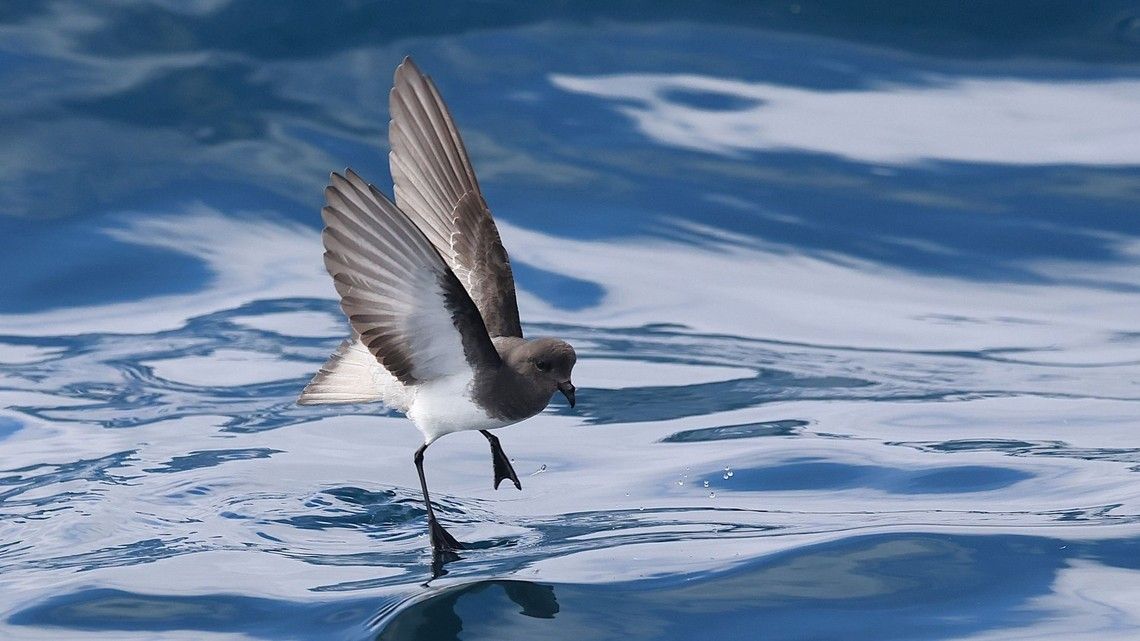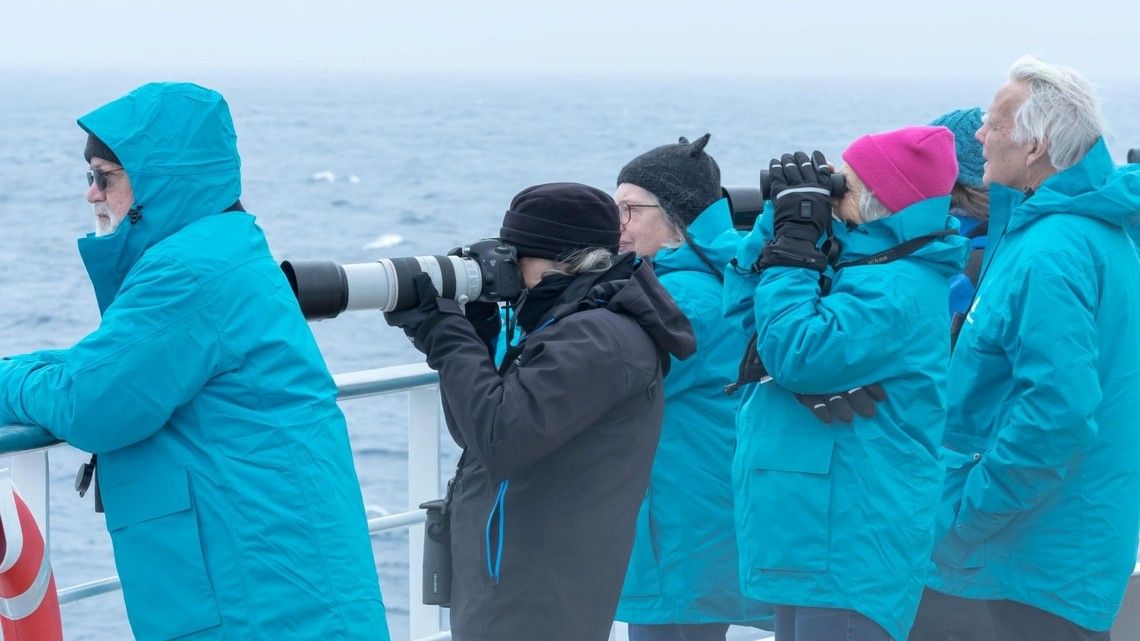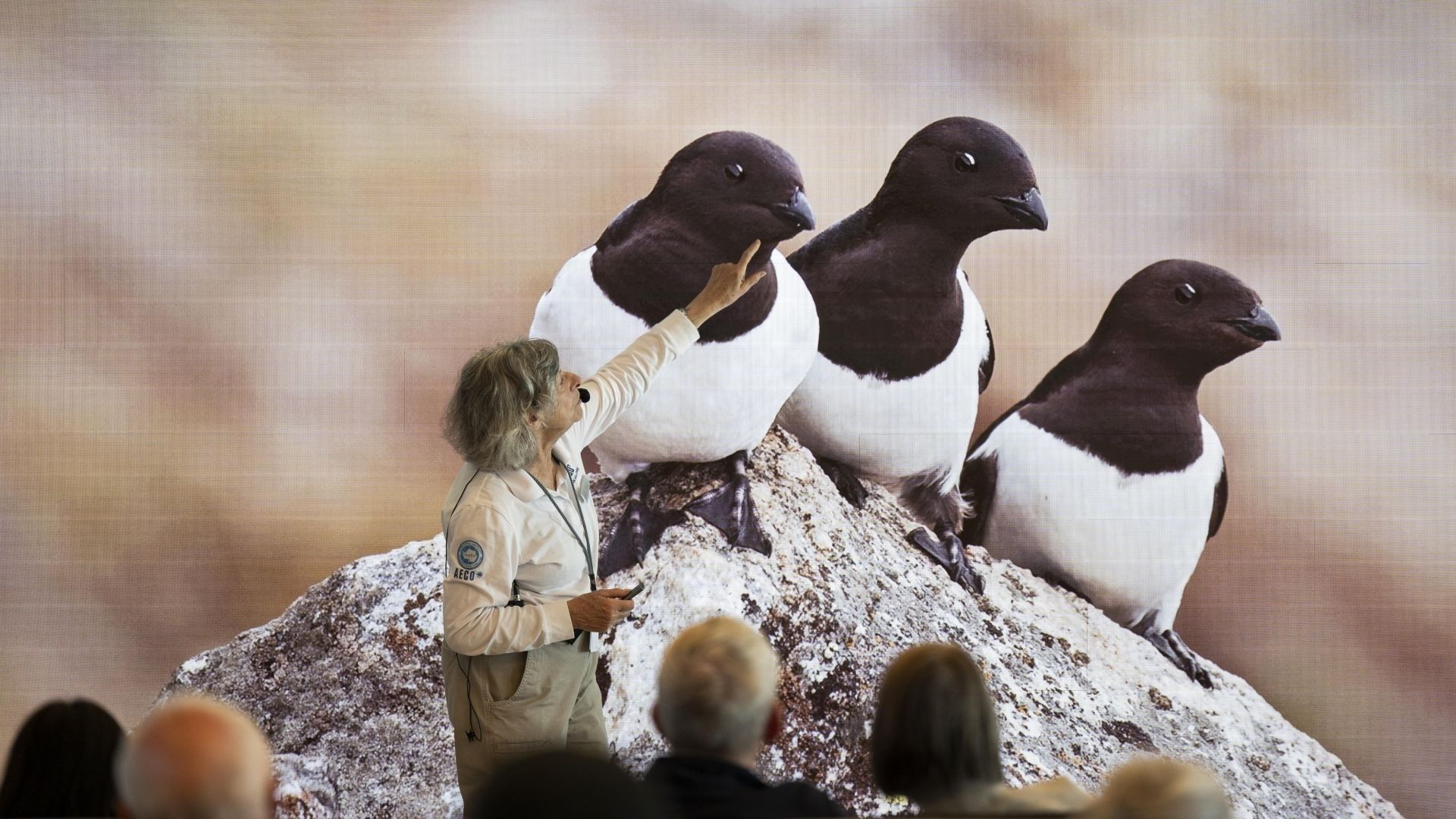Lecturer and accredited bird ringer Sue Walsh talks to us about her journey into ornithology, the art of bird ringing, and what guests can look forward to when birdwatching aboard our ships.
Hi Sue, how did you first become involved in ornithology?
Sue: I grew up in London without real knowledge or interest in the natural world around me. However, I ended up studying geology at university and that changed my perspective. I started to observe the landscape and try to understand how it had been formed. It wasn’t until my thirties that I started to become interested in birds. I was camping in Scotland and emerged from my tent one morning to see a bird on the path. I wondered what species it was, and bought a bird book and a pair of £30 binoculars. The bird turned out to be a chaffinch. That was the start of my interest in birds. I have since seen nearly six thousand species worldwide. I still have the old Collins bird guide, but the binoculars have long gone and been upgraded several times, costing a lot more than £30!

How to become a bird ringer
How has your work evolved over the years?
Sue: Being out and about bird watching, I began to learn about the other flora and fauna around me, and when I started working on ships in 2013, I started to watch the creatures of the sea. These days, birds are still my speciality, but I lecture on all aspects of wildlife.
Please explain what being an accredited bird ringer/bander means, and what unique experiences it has provided you.
Sue: I am an accredited bird ringer/bander. We catch birds mostly using runs of fine nets and attach a band with a unique identifying number. We take measurements and note information about the birds, such as species, age, stage of molt, breeding condition, etc., and then release the bird. If the bird is trapped again, it will help us to understand the life and movements of the bird and the species. Studying the birds in this way allows a much deeper understanding of how birds live their lives. I usually ring with a group of people in Sussex where I live, but I have also ringed abroad with other groups in Gibraltar, Turkey, and Israel, allowing me to widen my experience and ring different species.
How do you make your lectures so interesting?!
Sue: I find when lecturing on ships, it’s my passion and interest in the subjects which connects with people. Also, a sense of humor. I usually build in something to make people smile. I see myself as an informer and entertainer. I also try and include interesting facts about how birds live their lives. It is amazing how creatures adapt to their environment. They are all different. I have a variety of lectures not only on wildlife. I include some history, geology, food, and other information about our destinations. Anything which people might find of interest. I also have many '10 Tips' talks on how to live longer, improve your memory, etc., full of practical tips and funny stories.

What is the best time and place on board for birdwatching during expeditions?
Sue: At sea, the more time you spend on deck watching for wildlife, the more you will see. There is no specific time of day which is best. Wildlife can appear at any time, it is very relaxing to spend time on deck looking at the sea and, in the case of cetaceans, waiting for the sea to reveal its secrets. The best place to watch is looking forwards in the direction of travel. However, this can often be windy, so I most often will stand at the back where it is sheltered.
What birdwatching recommendations do you offer guests who want to maximize their experience?
Sue: Antarctica is always exciting and one of the most unique experiences on the planet. There are albatrosses to be seen as we cross the Drake Passage with their huge wingspans up to 3.6 meters (12 feet) cruising effortlessly past us. Also, the tiny Storm-Petrels which flutter alongside the ship and dip their feet in the water to disturb the surface to find food. Giant-Petrels follow the ship criss-crossing our wake searching for anything churned up by our propellers and fixing us with their beady eyes as they float past us. And when we get to Antarctica, there are the penguins of course, sometimes thousands of them, busy breeding in the Austral summer. They are sitting on eggs, then looking after the chicks as they grow and trying to protect them from the skuas who patrol the colonies looking for an opportunity to steal an egg or a chick. There are many predators on land and in the sea where leopard seals and Orca are also on the lookout for a penguin snack. This is all playing out in the most dramatic scenery of ice, snow, and rock and makes it an amazing experience. Across four seasons in Antarctica, I have spent a total of a year sailing there, and it is always exciting with something new to see.

What upcoming voyages do you have planned, and what are you most looking forward to about them?
Sue: This year I am going to Greenland. This is also one of my favorite places and I have been several times before. In place of penguins, there are auks in the water and breeding on the cliffs, and eagles soaring overhead. The cetaceans are also wonderful to see, as well as interesting mammals, such as Musk Ox and Arctic Hare. The culture, art, and jewelry add another dimension to this fascinating part of the world.
Useful tools for birdwatching
Guests get to use Nikon Prostaff 3S 10x42 binoculars when they sail with Swan Hellenic. Can you tell us why they’re so useful?
Sue: On Swan Hellenic ships, you are provided with a pair of binoculars. Do take these with you every time you go on deck or ashore. You see so much more with them and they will help you distinguish the different species. If you are new to using binoculars, spend a little time getting used to finding an object and focusing on it. The best way is to go outside and focus on an object which is not moving – part of the ship if you are on board – and just practice. The wildlife is sometimes not around for long and you want to be able to see it quickly when it appears.
How do you prepare for different ecosystems and the specific bird species you may encounter in each location?
Sue: The best way to prepare for seeing the creatures on your trip is to get a field guide for the country of your destination. It might be for birds, cetaceans, or the flora. Of course, there are many apps, which can be very helpful and save carrying heavy books with you. For birds, the Merlin guide has become very popular and I use it myself to help with the identification of birds in the field. It also has a facility for identifying calls and songs and will tell you what birds you are hearing. For most taxa and for flora in particular, the Seek App is very helpful and can identify most trees and plants (as well as insects and a wealth of other wildlife) through the camera facility on your phone. Your basic equipment for wildlife watching will always be your eyes and ears, supplemented by a pair of binoculars and a field guide (a book or app).

Common misconceptions about birdwatching or ornithology
Sue: One of the most common things people say of the birds when we are at sea is: 'They are a long way from home' meaning they are far from land. Of course, there are land birds which cross the sea when they migrate. But most often the birds we see at sea – the albatrosses, shearwaters, and petrels – are sea birds and the ocean is their home. Their food is in the sea and they only come to land to breed. The next most common questions are: 'How do they sleep?' and 'Do they sit on the water to sleep?'. Sea birds sleep in a very different way from humans. They can sleep on the wing. They shut down part of their brain at a time so they continue to be able to fly and function while they rest their brain. They can also sleep for just a few seconds at a time. So a bird may take thousands of ‘naps’ during one day!
What are your favorite birdwatching locations around the world?
Sue: People ask me this a lot. However, when it comes to my favorite places to go birdwatching, every place is special and has its own range of interesting and unique species.
What role does conservation play in your work as an ornithologist, and how do you communicate its importance to guests?
Sue: As travelers and naturalists, it is important to be mindful of measures to help with the conservation of birds and their habitats. If we do not do that, there will be fewer birds to see in the future. On the ship, we always talk about and implement mandatory conservation and biosecurity measures. We ignore these at our peril. In my lectures, I will touch on the impact of our actions on particular species and measures we or others can take for their protection. The key issue for all of us is awareness and respect for the wildlife. We are in their world, and we should give them the respect and space they need. We would not like it if people were all around our house pressing their noses against the window and pushing camera lenses in our faces. We need to be aware of when our presence is changing their behavior and step back. I often also mention the impact of plastic, particularly at sea. Old balloons and plastic bags, for instance, kill whales and dolphins as they accumulate in their stomachs and they die of starvation. The same fate awaits albatross chicks, which are fed plastic items floating in the sea.

Can you share an impactful experience from your birdwatching travels?
Sue: Recently I went bird watching in New Zealand. One of the highlights was pelagic trips where we went out in a small boat for several miles and then stopped and threw out what they call ‘chum’, i.e., fish and off cuts. The birds soon smell it with their incredible sense of smell, and at one point we were surrounded by a hundred albatrosses and many other species. It was amazing to see these huge creatures so close and observe them for a couple of hours!
